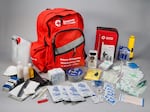
The American Red Cross recommends each household have a backpack with emergency supplies for evacuation.
American Red Cross
The unknown often plays an outsized role in disaster preparation for earthquakes and other natural events.
You don’t know how bad the shaking will be during the 8.0 or 9.0 earthquake that could come from the Cascadia Subduction Zone fault line in the next 50 years. Nor do you know where you’ll be or exactly how well the building you’re in may survive that shaking.
The best way to mitigate those unknown factors, according to experts, is to have a plan in place for various scenarios. In the event that you end up without a place to shelter after a major earthquake, a mobile "go-kit" should be part of your scenario planning. People who live in a tsunami inundation or landslide zone may especially need to evacuate at a moment's notice.
According to Alice Busch, training coordinator for Multnomah County Emergency Management, the specific supplies you need could vary depending on your particular situation.
"Each person should consider their individual needs and skills and build their kits around that," she said. "For example, a mental health provider, EMT, parent, and engineer are going to have very different tools in their go kits."
A mobile kit should have enough supplies to last at least three days, which should give enough time to find a more permanent shelter. People living in remote areas may need more supplies.
Multnomah County recommends that your go-kit has:
- Three days of food that doesn't need to be refrigerated or cooked for each family member
- Three gallons of water per family member
- Battery or hand-crank powered radio
- Flashlight
- Extra batteries
- First aid kit
- Supply of medications
- Multipurpose tool
- Copies of personal documents, such as insurance and identification
- Extra cash in small denominations
- Personal hygiene items
- Whistle to signal for help
- Local maps
- Duct-tape
- Manual can opener
- Household liquid bleach for water purification, plus eye dropper for measuring
- Waterproof matches
- Baby supplies if needed
- Pet supplies if needed
- Rain gear and warm clothes
- Insect repellent and sunscreen
- Extra clothing
- Emergency blankets
The American Red Cross also recommends that you always keep your vehicle filled with three-quarters of a tank of fuel in case you need to leave in an emergency.
